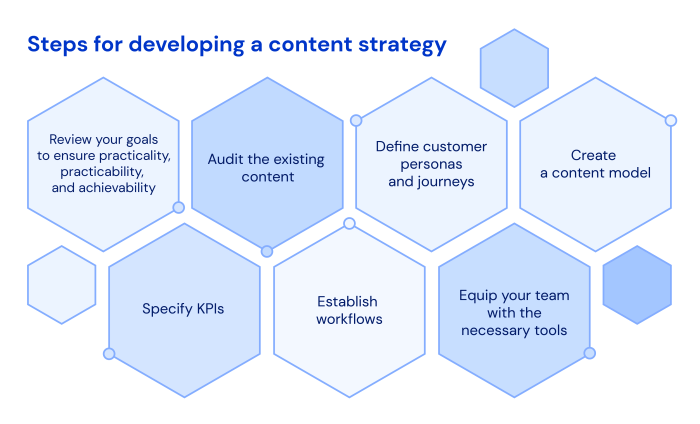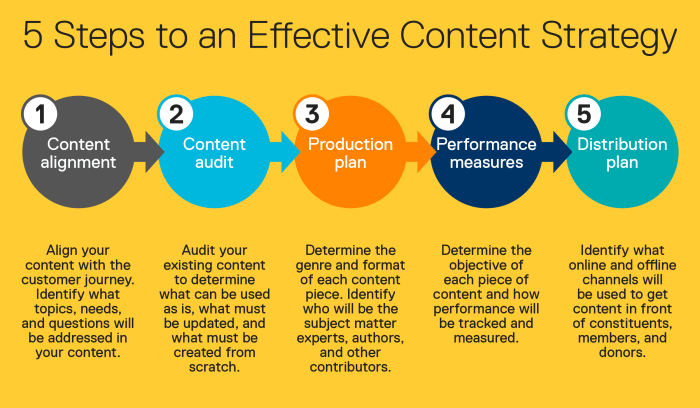Developing Content Strategies for Business Growth takes you on a journey through the essentials of creating compelling content that drives success. Get ready to dive into the world of content strategy with a fresh perspective and actionable insights.
In today’s digital age, content strategies play a vital role in shaping the success of businesses. From defining key components to understanding audience personas, this guide covers it all.
Definition and Importance of Content Strategies: Developing Content Strategies
Content strategies are the backbone of any successful business marketing plan. They involve planning, creating, and distributing valuable and relevant content to attract and retain a target audience. These strategies are crucial for businesses as they help in establishing brand identity, increasing brand visibility, and driving customer engagement.
Examples of Successful Companies
- Apple: Known for its sleek and innovative product launches, Apple has effectively used content strategies to create buzz and anticipation among its loyal customer base.
- Red Bull: Through its extreme sports sponsorships and content creation, Red Bull has successfully built a lifestyle brand that resonates with its target audience.
- Dove: With its “Real Beauty” campaign, Dove has utilized content strategies to promote body positivity and diversity, resonating with consumers on a personal level.
Achieving Marketing and Business Goals
- Increased Brand Awareness: By consistently delivering valuable content, businesses can increase their brand visibility and attract new customers.
- Improved Customer Engagement: Content strategies help in creating a connection with customers, leading to increased loyalty and repeat business.
- Higher Conversion Rates: Quality content can drive leads and conversions by providing valuable information that addresses the needs of the target audience.
Developing a Content Strategy Framework

In order to create a successful content strategy, it is crucial to have a solid framework in place. This framework serves as a roadmap for your content creation efforts, ensuring that they align with your overall goals and objectives. Here are the key components of a content strategy framework:
Key Components of a Content Strategy Framework:
1. Audience Analysis:
- Identifying your target audience and understanding their needs, preferences, and behaviors is essential for creating relevant and engaging content.
- Use tools like analytics, surveys, and social media insights to gather data about your audience.
2. Brand Messaging:
- Define your brand voice, tone, and messaging guidelines to ensure consistency across all content.
- Establish key messages that reflect your brand values and resonate with your target audience.
3. Content Goals and Objectives:
- Set clear and measurable goals for your content strategy, such as increasing brand awareness, driving website traffic, or generating leads.
- Align your content objectives with your overall business goals to ensure a cohesive strategy.
4. Content Calendar and Planning:
- Develop a content calendar to organize your content creation schedule and ensure timely publication.
- Plan your content topics, formats, and distribution channels in advance to maintain consistency and relevance.
5. Performance Measurement:
- Monitor and analyze the performance of your content using key metrics like engagement, conversions, and ROI.
- Use insights from performance data to optimize your content strategy and make data-driven decisions.
6. Team Roles and Responsibilities:
- Assign roles and responsibilities within your content team to ensure accountability and efficiency.
- Define workflows and processes for content creation, review, and publication to streamline operations.
Audience Research and Persona Development

Understanding your audience is crucial in developing a successful content strategy. By conducting thorough audience research, you can tailor your content to meet the specific needs, preferences, and behaviors of your target demographic.
Importance of Audience Research
Before creating any content, it’s essential to know who your audience is. Audience research helps you identify the demographics, interests, and pain points of your target market. This information allows you to create content that resonates with your audience and drives engagement.
Creating Audience Personas
Creating audience personas involves developing fictional representations of your ideal customers based on real data and research. These personas include details such as age, gender, job role, challenges, goals, and preferred channels of communication.
Influence on Content Creation, Developing Content Strategies
Once you have established audience personas, you can tailor your content to speak directly to each persona’s needs and preferences. For example, if one of your personas is a busy professional looking for quick tips, you can create concise, actionable content to cater to their preferences.
Examples of Persona-Driven Strategies
- Company A identified two main audience personas: young students and working professionals. By creating separate content campaigns targeting each persona with relevant topics and language, they saw a significant increase in engagement and conversions.
- Brand B developed an audience persona named “Tech-Savvy Sally,” who was interested in the latest technology trends and product reviews. By tailoring their content to meet Sally’s preferences, they gained a loyal following of tech enthusiasts and saw a boost in website traffic.
Content Creation and Distribution
Creating valuable and engaging content for target audiences is crucial in today’s digital landscape. It helps build brand awareness, establish credibility, and drive customer engagement. By understanding your audience’s needs and preferences, you can tailor your content to provide them with relevant and useful information that resonates with them.
Choosing the Right Channels for Content Distribution
When it comes to distributing your content, it’s essential to choose the right channels to reach your target audience effectively. Consider factors such as the demographics of your audience, their preferred platforms, and the type of content they engage with the most. Whether it’s social media, email marketing, or blog posts, selecting the appropriate channels can maximize your content’s reach and impact.
- Utilize social media platforms that align with your target audience’s preferences. Whether it’s Instagram for visual content, Twitter for short updates, or LinkedIn for professional insights, choose platforms where your audience is most active.
- Consider email marketing as a direct and personalized way to distribute content. Segment your email lists based on user preferences and behaviors to deliver relevant content that resonates with each subscriber.
- Optimize your website for search engines to increase organic traffic. By incorporating relevant s, meta descriptions, and high-quality content, you can improve your website’s visibility and attract more visitors.
Optimizing Content for Different Platforms and Formats
Adapting your content to fit various platforms and formats is essential to ensure it reaches a wider audience and remains engaging across different channels. Here are some tips to optimize your content effectively:
- Create visually appealing content by incorporating images, videos, and infographics to enhance engagement and convey information more effectively.
- Format your content for readability by using bullet points, headings, and short paragraphs to break up text and make it easier for readers to consume.
- Experiment with different content formats such as podcasts, webinars, and interactive quizzes to cater to diverse audience preferences and capture their attention in unique ways.












